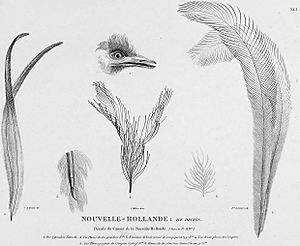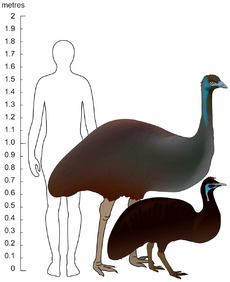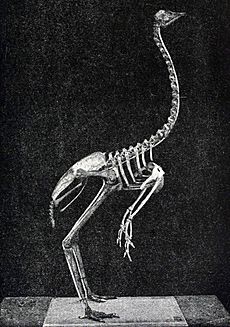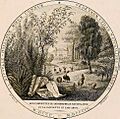King Island emu facts for kids
Quick facts for kids King Island emu |
|
|---|---|
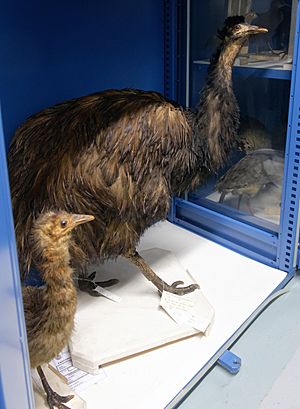 |
|
| Adult and juvenile specimens, Muséum national d'Histoire naturelle, Paris | |
| Conservation status | |
| Scientific classification |
|
| Kingdom: | Animalia |
| Phylum: | Chordata |
| Class: | Aves |
| Order: | Casuariiformes |
| Family: | Casuariidae |
| Genus: | Dromaius |
| Species: | |
| Subspecies: |
†D. n. minor
|
| Trinomial name | |
| Dromaius novaehollandiae minor (Spencer, 1906)
|
|
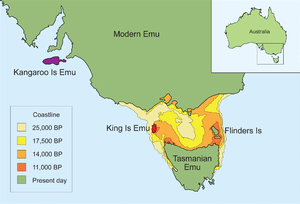 |
|
| Historical distribution of emu taxa (King Island emu in red) and ancient shorelines around Tasmania | |
| Synonyms | |
|
List
Casuarius diemenianus Jennings,1827
Dromaeus parvulus Broderip, 1842 Dromaeus minor Spencer, 1906 Dromaius peroni Rothschild, 1907 Dromaius bassi Legge, 1907 Dromaius parvulus Mathews, 1910 Dromiceius spenceri Mathews, 1912 Peronista peroni (Mathews, 1913) Dromaius diemenianus (Morgan & Sutton, 1928) |
|
The King Island emu (Dromaius novaehollandiae minor) was an extinct type of emu. It lived only on King Island, which is located in the Bass Strait between mainland Australia and Tasmania. This emu was the smallest of all known emus.
Scientists believe its closest relative was the extinct Tasmanian emu. Both lived in the same area until about 14,000 years ago, when King Island was still connected to Tasmania. The King Island emu was much smaller than the mainland emu. This smaller size is an example of insular dwarfism, where animals on islands become smaller over time.
The King Island emu had darker feathers than the mainland emu. It was black and brown, with bare blue skin on its neck. Its chicks had stripes, just like mainland emu chicks. The King Island emu behaved much like the mainland emu. They gathered in groups to find food and during breeding season. They ate berries, grass, and seaweed. They could run very fast and used kicks to defend themselves. Their nests were shallow and made of leaves and moss. Both parents helped to incubate the seven to nine eggs.
Europeans first found the King Island emu in 1802. Most of what we know about them comes from a French naturalist named François Péron. He interviewed a sealer on the island and saw drawings by artist Charles Alexandre Lesueur. Live and stuffed King Island emus were sent to France in 1804. The last two known King Island emus died in a zoo in Paris in 1822. Hunting and fires likely caused the wild population to disappear by 1805.
Contents
Understanding the King Island Emu
For a long time, scientists were confused about the small emus from King Island and Kangaroo Island. This was because specimens from both islands were brought to France at the same time in the early 1800s. The records from the expedition didn't clearly state where each emu came from. This led to many different scientific names being given to these birds.
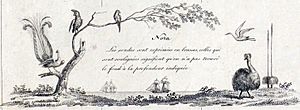
In 1906, an Australian scientist named Walter Baldwin Spencer gave the name Dromaius minor to the King Island emu. He based this on old bones and eggshells found on the island. Later, in 1990, scientists used special tests to confirm that the emu skin in a Paris museum was indeed from King Island. This helped clear up some of the confusion.
Today, the King Island emu is considered a subspecies of the mainland emu, called Dromaius novaehollandiae minor. This means it's a type of emu, but it's different enough to be its own group. Other animals on King Island are also considered subspecies of their mainland relatives.
How the King Island Emu Evolved
Small emus lived on several islands off Australia a long time ago. Besides the King Island emu, there were also emus on Kangaroo Island and Tasmania. All of these are now extinct. The King Island emu lived on a small island in the Bass Strait, about 100 km (62 mi) from both Tasmania and mainland Australia.
King Island was once connected to Tasmania and mainland Australia by a land bridge. But as sea levels rose after the last ice age, the island became separated. Because it was isolated on a small island, the King Island emu likely became smaller over time. This is a process called insular dwarfism.
Studies of their DNA show that the King Island emu is very closely related to the mainland emu. This suggests they were separated from the mainland emus fairly recently, about 14,000 years ago. This also means the extinct Tasmanian emu is probably closely related to both the King Island emu and the mainland emu.
Scientists have found that the size of these island emus was related to the size of the island they lived on. The King Island emu was the smallest because King Island is the smallest of these islands. This suggests that limited resources on smaller islands might have caused them to become smaller.
What the King Island Emu Looked Like
The King Island emu was the smallest type of emu. It was about half the size of the mainland emu, standing around 87 cm (34 inches) tall. The heaviest ones weighed about 20 to 23 kg (45 to 50 lb).
It had darker feathers, with a lot of black on its neck and head. Its body feathers were blackish mixed with brown. Its beak and feet were blackish, and the bare skin on the side of its neck was blue.
Scientists found no special genes that would explain its dark color. It might have been due to other genetic factors or even its environment. According to one early observer, there wasn't much difference between male and female King Island emus. However, male mainland emus are usually smaller than females and can change color during mating season.
Old bones of the King Island emu show that its leg bones were shorter than those of the mainland emu. For example, its shin bone (tibia) was about 330 mm (13 inches) long. Its thigh bone (femur) was about 180 mm (7 inches) long.
The King Island emu and the mainland emu looked very similar, except for their size. Some thought the King Island emu had a more dome-shaped head, but this feature can also be seen in young mainland emus.
Life and Habits
A naturalist named François Péron interviewed a local sealer and learned about the King Island emu's behavior. He wrote that the birds usually lived alone. But during breeding season, they would gather in groups of ten to twenty. After breeding, they would go off in pairs.
They ate berries, grass, and seaweed. They mostly looked for food in the morning and evening. They were fast runners, but perhaps slower than mainland emus because they were fatter. They could swim well but only did so when they had to. They liked shady areas near lagoons and the shoreline, not open spaces. They used a claw on each wing to scratch themselves. If they couldn't escape from hunting dogs, they would kick to defend themselves. These kicks could cause a lot of harm.
Another naturalist, Robert Brown, studied their droppings in 1802. He found that they mainly ate the berries of a plant called Leptecophylla juniperina. An old report also said they gathered in groups of 70 to 80 while feeding. Hunters used this behavior to catch them. Most emu bones found on King Island were on the drier west coast. This suggests the emus might have lived mostly in coastal and open inland areas, not in the dense forests.
Reproduction and Life Cycle
Péron said that the King Island emu's nest was usually on the ground near water, under a bush. It was made of sticks and lined with dead leaves and moss. The nest was oval-shaped and not very deep. He claimed that seven to nine eggs were laid on specific dates in July.
The female emu incubated the eggs. However, the male also developed a special patch on its skin, which means it helped with incubation too. The parent not incubating would stay near the nest. The chicks left the nest two to three days after hatching. Snakes, rats, and quolls would sometimes eat the eggs. Péron estimated the incubation period was five or six weeks, but for mainland emus, it's closer to 50 to 56 days. He also said a mother emu would defend its young from crows with its beak, but we now know this is usually male behavior.
How Humans Affected Them
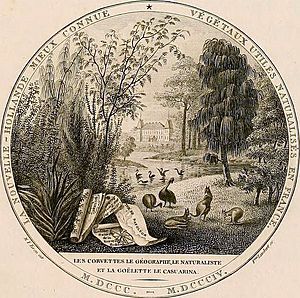
Europeans first learned about the King Island emu in 1802. Later that year, Captain Nicolas Baudin's French expedition visited King Island. François Péron, a naturalist on this trip, was the last person to describe the King Island emu in the wild. Péron and his companions once got stuck in a storm and stayed with some seal hunters. They ate emu meat, which Péron said tasted good, like a mix of turkey and young pig.
Péron didn't see any emus himself on the island. Most of his information came from an interview with a local sealer named Daniel Cooper. Péron asked if the emus could be raised in captivity and how to cook them. This interview was not published until 1899, so little was known about the bird for a long time.
Emu Specimens Sent to France
Several King Island emus, both alive and as skins, were sent to France as part of the expedition. Some of these are still in European museums today. At least two live King Island emus were taken to France in March 1804. These birds had a rough journey because of bad weather on the ships. Some died, and others had to be force-fed.
The two live King Island emus were first kept at Empress Josephine's menagerie. After a year, they moved to the Jardin des Plantes (a botanical garden and zoo). The "female" died in April 1822, and its skin is now in the Muséum national d'Histoire naturelle in Paris. The "male" died in May 1822, and its skeleton is in the same museum. A feather from the Paris skin is now in the Tasmanian Museum and Art Gallery.
There is also a skeleton in the Royal Zoological Museum, Florence. It was mislabeled as a cassowary for many years until it was correctly identified in 1900. This skeleton is a mix of bones from two different King Island emus.
Drawings of the Emu
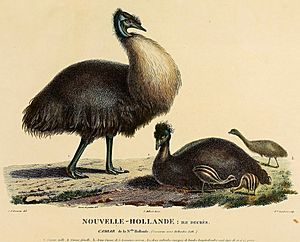
François Péron's book about the expedition, published in 1807, includes a drawing of "casoars" (a term used for both emus and cassowaries) by Charles-Alexandre Lesueur. The drawing shows two adult birds and some juveniles. However, the scene might not be real, as breeding emu pairs usually split up when the male starts incubating.
Some experts believe the larger bird in the drawing is a Kangaroo Island emu, and the smaller, darker one is a King Island emu. The drawing might have been based on the captive birds in the Jardin des Plantes, not wild ones.
Why the King Island Emu Disappeared
We don't know the exact reason why the King Island emu became extinct. Soon after the birds were discovered, sealers settled on the island because there were many elephant seals. Péron's interview with Daniel Cooper suggests that hunting played a big role in the emu's disappearance. Cooper even claimed to have killed 300 emus himself in just six months. His group of sealers, which included eleven men and his wife, might have killed 3,600 emus by the time Péron visited them.
Péron explained that the sealers ate a huge amount of meat. Their dogs also killed several animals every day. Since the emus might have lived mostly in coastal areas, they were easy targets for the sealers. Natural fires might have also played a part.
It's likely that the two captive emus in France, which died in 1822, were the last of their kind. The wild King Island emu population may have become extinct in the wild as early as 1805. They were definitely gone by 1836, when English settlers arrived on the island. The elephant seals also disappeared from the island around 1819 due to too much hunting.
Images for kids
-
Adult and juvenile specimens, Muséum national d'Histoire naturelle, Paris
-
1807 cartouche of a small emu and other birds from a map of south east Australia and Kangaroo Island
-
Two small emus and other animals outside Château de Malmaison
-
1807 plate by Lesueur, perhaps showing this subspecies on the right
-
1807 plate by Lesueur showing elephant seals and sealers (middle) on King Island
See also
 In Spanish: Emú negro para niños
In Spanish: Emú negro para niños



